RESEARCH ARTICLE
Modelling Exchange with Blockchain for the Collaborative Design of a Building Envelope in BIM
Chih Lin Hsu1, Jui Tang Wang2, *, Huang Jun Xie3
Article Information
Identifiers and Pagination:
Year: 2024Volume: 17
E-location ID: e18748368259109
Publisher ID: e18748368259109
DOI: 10.2174/0118748368259109231129210622
Article History:
Received Date: 25/07/2023Revision Received Date: 29/09/2023
Acceptance Date: 04/10/2023
Electronic publication date: 31/01/2024
Collection year: 2024

open-access license: This is an open access article distributed under the terms of the Creative Commons Attribution 4.0 International Public License (CC-BY 4.0), a copy of which is available at: https://creativecommons.org/licenses/by/4.0/legalcode. This license permits unrestricted use, distribution, and reproduction in any medium, provided the original author and source are credited.
Abstract
Introduction
The main challenge in using building information modelling (BIM) is the centralised collaborative framework in the various design software (e.g., AutoCAD, Revit, RHINO, and ArchiCAD) used by professionals across various disciplines, which causes difficulties during data exchange.
Methods
The existing framework may increase the project lead time, require more effort, and result in design conflicts and misunderstandings. Thus, this paper has proposed a dynamic information storage with blockchain system (DISBS) using a physical curtain wall project for practical implementation. In addition, this paper has further discussed the linkages and verified and analysed the effectiveness of the proposed methodology.
Results
Through the DISBS proposed in this research, the characteristics and achievable functions of blockchain technology are presented. Various applications for the field of construction engineering are highly developable within this research.
Conclusion
The DISBS can improve not only the management quality of construction projects, but also promote mutual trust in the construction industry and optimize architecture, engineering, and construction (AECO) productivity.
1. INTRODUCTION
In recent years, building information modelling (BIM) [1] has become a comprehensive collaborative process in the architecture, engineering, and construction (AEC) industry [2]. Architectural design is a process in multiple fields that requires architects and engineers to work together [3]. Design engineers typically use various design tools to complete related work tasks [4]. When information exchange becomes inevitable, information interoperability is the most important core issue [5]. The International Standards Organisation (ISO) 19650-1 [6] series has applications primarily at level 2 maturity, predominantly using a common data environment (CDE) (Fig. 1) [7] based on information management technology. In addition, different design tools are used to complete the design using the currently proposed cooperation method, and the
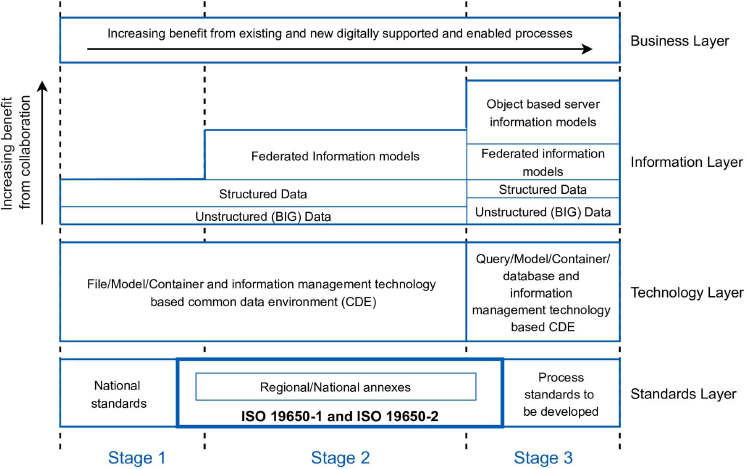 |
Fig. (1). ISO 19650-1 analogue and digital information management – file/model/container and information management technology based on the common data environment (CDE). |
Industry Foundation Classes (IFC) file format [8] must be exported when collaborative data exchange is needed. Different design tools require the exportation of a unified IFC file for data information categorisation and integration [9, 10]. James Heatona et al [11]. proposed extracting BIM-related data directly from the model (IFC file format), transferring them to the data centre and performing related collaborative operations with the existing asset management system. Based on the complex and unclear interrelationships of traditional project management information, which result in coordination and cooperation, owner-centred project management information is proposed [12]. However, this improvement is based on owner-centred management, resulting in problems regarding the absence of sharing and delays of information.
Finally, a study [12] has proposed a BIM-based construction project collaboration process that used IFC files for collaborative management. BIM360 aims to handle large, complex data management solutions, which usually require excessive amounts of time to implement in today’s AECO industry. The software aims to deliver a complete, accurate, and digital view of design and construction projects to multidisciplinary teams in the office or in the field. However, in a BIM360 environment, a single live model needs to be generated by multidisciplinary teams, which cannot present each engineer’s revision records in the same model file. Additionally, the revision historical records and timestamps are made by each different engineer in various teams. Therefore it might be difficult to clarify the responsibility and keep the correct workflow sequence in a project [13]. Based on the abovementioned collaborative cooperation, the following problems arise: 1. It is difficult to perform information management for architectural design. 2.
Responsibility attribution is unclear when problems occur in architectural design. 3. It is difficult to trace the various scenarios of architectural design at different points in time. 4. Architectural design information is stored only in a centralised database, resulting in data security and integrity issues [14]. 5. Copyrights for designers cannot be protected. 6. An additional collaborative operating environment is required and must be integrated with existing architectural software.
As mentioned above, information is stored in a centralised database, which may be accessed by users from different sources [15]. Blockchain [16] is a distributed database composed of data blocks. Various computing nodes on the network share the database and are responsible for the task of creating data blocks. As mentioned in an earlier study [17], data security is the main issue in this situation because stored data can be hacked or falsified. Thus, clarifying specific blockchain technology that can improve the current problems of the AECO industry is needed, but it has not yet been applied in the industry. A previous publication [18] proposed the idea of connecting RHINO/Grasshopper [19] and blockchain, explaining the value that blockchain contributes to building ecosystems; however, only simple data information is used to connect the application and the actual application of the building project has not yet been carried out. A public data environment framework for collaborative BIM design, which uses blockchain and interplanetary file systems (IPFSs) [20] to complete distributed joint operations, has been proposed [21, 22]. Although the proposed design in this paper has not continued the use of IPFS technology combined with blockchains to achieve decentralised collaboration [23], it uses files as the basis for cooperation.
Based on the above analysis of the current situation, the motivation of this paper is as follows:
1 Project information management cannot be performed when a design changes under integration and when no reliable information is recorded, or no traceable responsibility is provided.
2. It is difficult to trace the status of the detailed architectural design at different design stages in time.
3. Additional third-party software or platforms are required to share files in IFC when designing collaborative architectures. 4. This approach increases the risk of loss, conflict, or misunderstanding during design collaboration. Problems of insecurity, high complexity, and high latency exist. 5. The current collaborative architecture is vulnerable to attack or tampering. 6. In the same project design, the relevant information is changed (e.g., the length, width, and height of the project model), and there is no related traceable record, resulting in the loss of copyright protection. These results demonstrate data security issues in data centres and integrity issues when the design is stored only in a centralised database.
This paper has proposed a dynamic information storage and blockchain system (DISBS) for architectural design processing to achieve the following: 1. The information on building project design is synchronously integrated with the database, and the information on the building components is stored and managed to ensure the integrity of the data and the future design, manufacturing, construction, and operation process. 2. Data integration with the blockchain protects the rights of the original designer and records the modified information of the building components to ensure that the process and responsibility of the tampered version are maintained. 3. In terms of the perspective on the stages of maturity of analogue and digital information management, the proposed system advances towards stage 3 in several ISO 19650 areas (Fig. 1). 3.1 In the standard layer, the process of the method proposed in this paper is regarded as a possible collaborative process in future ISO 19650-1 stage 3 imple-mentation. 3.2 In the technology layer, the query/model/ container/database and information management technology-based CDE are used for collaboration. 3.3 In the information layer, object-based server information models are used to implement the basic model of the component knowledge base for project design. A single design model is imported into a single design software system to complete the use of federated information models. The proposed approaches manage both structured data and unstructured (big) data.
Related works have introduced several papers on the concept and use of blockchain in construction management and presented the current collaborative cooperation platform based on BIM. In contrast, the proposed approach introduces the system architecture of the proposed method and introduces the microservices in the architecture. The proposed approach also introduces the processes of generating, searching, and verifying records in the system architecture. The case study presented here takes a curtain wall project as a practical implementation and uses the developed system architecture to complete the project design. Finally, in this paper, the results analysis, systematic record search and verification processes, and the time delay data analysis of the overall construction project, are presented. This study demonstrates that the proposed approach not only focuses on the purpose of the technology layer of ISO 19650 part 1 stage 3 (Fig. 1), but also addresses construction industry security concerns when working with external collaborators. The conclusion summarises the methodology of the paper and the construction industry validation analysis of the curtain wall project and explains the possible directions for future research.
2. MATERIALS AND METHODS
2.1. Overview of Blockchain Technology in Construction Engineering Management
Wang et al. [17] primarily explained how to improve the current potential of the construction industry using blockchain technology, in addition to discussing three types of blockchain applications. The first type was a notarisation-related application, which could eliminate the time it takes to verify the authenticity of the document. Through the implementation of blockchain technology, each file can be stored in the distributed ledger and created and deleted as needed; thus, the update has perfect notarisation. The second type of application is a transaction-related application, which can facilitate automatic purchases and payments. Any property can be easily transferred, including tangible and intangible properties, and the ownership is controlled by blockchain. In the construction field, there are often disputes related to payment, technology transfer, equipment leasing, and house sales. With this type of application, much time can be saved if all processes are automatic and neutral. The third type of application is a provenance-related application, which can improve the transparency and traceability of the architectural supply chain. In addition,
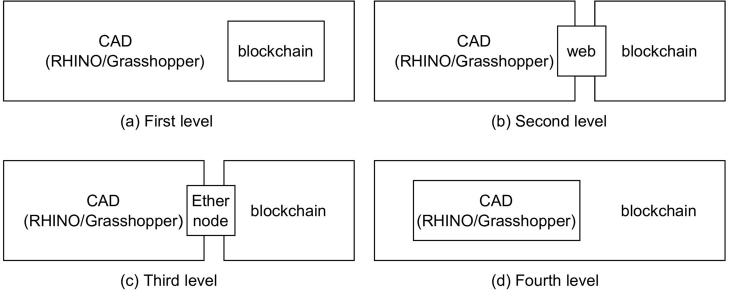 |
Fig. (2). The four-level relationship between blockchain and CAD. |
because each transaction is visible in the blockchain ecosystem, it is easy to trace the supply of authentic products or services. Because all the records stored in the blockchain system are true and cannot be modified, it is possible to quickly identify and confirm the party responsible for a potential problem without the need for cumbersome argumentation. The following paper also mentions that in the future, blockchain will be used to perform an increasing number of case studies in the architectural field and evaluate the effectiveness of blockchain systems [24, 25]. Although the studies have explained that using blockchain technology can improve the existing problems of the current architecture industry and the challenges it faces [26], blockchain technology has not yet been applied to actual building cases.
2.2. The Strategy of Blockchain Integration in a Computer-aided Design (CAD)
Dounas and Lombardi [18] primarily explained the proof-of-concept implementation of connecting CAD [27] and blockchain, proposing four a, b, c, and d levels. However, only the first (Fig. 2a) and second layer (Fig. 2b) concepts were implemented and guaranteed. The first level (Fig. 2a) integrated the basic Python-written blockchain into the Grasshopper environment. The designer drew the circle and copied it from its position to another position, calculating the coordinate difference and inputting it into the Python-written blockchain [28]. The blockchain was executed internally and did not create an external connection.
The second level (Fig. 2b) took a surface drawn by Grasshopper and proposed a proof-of-concept optimisation algorithm to calculate the highest point on the surface. This value was transmitted through the network in the form of a percentage. Currently, smart contracts [29] for Ethereum access can be implemented. Once the standard value is higher than the required minimum,the issued token is paid for on the Ethereum access blockchain. Overall, the smart contract on Ethereum is set to receive the optimised value through the web and the identity of the computing designer on the other part of the smart contract. The third level (Fig. 2c) builds the Ethereum node in Grasshopper and is responsible for Ethereum network communicating and registering the definition from Grasshopper. The Ethereum node can record the difference between the original and the follow-up document version and then record it as a block. The fourth level (Fig. 2d) involves the execution of a complete CAD/BIM application directly on the blockchain and transforms CAD/BIM into a decentralised application (DAPP) [30]. The abovementioned research proposed the feasibility of CAD integrated with blockchain and noted the challenges in terms of its actual application in the future.
2.3. Collaborative Platform for Building Design and Project Management
Lai et al. [9] primarily proposed a BIM-based platform for collaborative design and project management. The problem of data interoperability was solved, and the data exchange between the different design tools was handled in a simplified manner. The information exchange was based on the BIM collaboration format (BCF) [31]. Different design tools use the IFC data model for information exchange. BCF is a file format that aids in collaboration and works by transmitting data in the extensible markup language (XML) [32] format. XML formatted data are directly referenced by the view. Additionally, information related to problems with IFC coordinated through portable network graphic (PNG) is obtained, referencing BIM components from one application to another through the globally unique ID (GUID) of IFC. The present research proposes a BIM-based general platform consisting of five data-processing engines and a database (Fig. 3) to solve the challenges of limited data sharing, low efficiency during collaborative design, and difficulties in design communication. However, this research is based on the combination of the IFC model and part of the model extraction algorithm, which embeds the corresponding data processing engine into the proposed platform.
2.4. BIM Metadata Manipulation by Parametric Tools
In the work done by Khaja et al. [33], computer-aided facilities management (CAFM) of the BIM CDE data transmission method was proposed. The above work used parameterised tools to collect data from the CAFM system and transfer them to the BIM CDE data management process by using the application programming interface (API) [34], which protects the integrity of the CAFM data. Before operating and mapping the data to the BIM model, the system copies and exports the Microsoft Excel.xls format. Visual basic for applications (VBA) is used to sort, reformat, consolidate, and otherwise pre-process the data to align with the shared parameters defined in the BIM model. The Dynamo script maps the pre-processed data to the appropriate shared parameters and exports them to the BIM CDE. A previous study [33] used a general data environment in facility management by using a part of the parameter tool to automate pre-processing and transfer from the CAFM to the BIM CDE. Based on the lessons learned from the investigation in this research, this method needs to be modified. The way to improve this method is by using a consistent report format as much as possible to simplify the data transmission process from the CAFM to BIM. Alternatively, structured query language (SQL) [35, 36] can be used to query CAFM data instead of exporting them to.xls or.csv format. The data need to be filtered to reduce the overall file size. The last part also mentions that CAFM data can be queried directly with SQL instead of using a file as the basis. One of the four above-
mentioned studies illustrate the use of blockchain technology to improve the current problems in the construction industry, as well as the current technical challenges. The second study proposes CAD and blockchain, the feasibility of their integration, and the challenges that will be faced in future practical applications, but none of them have been applied in actual architectural cases. The third study proposes a general platform based on BIM, but the present study is based on the model combination of IFC files and partial model extraction algorithms to embed the corresponding data processing engine into the proposed platform. In the fourth research survey, the lessons learned need to be modified by the method and adopt a consistent file report format as much as possible. This related research also mentions that in the future, CAFM data an be queried directly with SQL instead of files in .xls or .csv format. However, it is necessary to communicate and use information based on the files.
3. PROPOSED APPROACH
This section proposes a system architecture to realise the use of blockchain technology to help solve existing problems in the construction field and apply it in practical projects. The proposed system architecture comprises three major processes: the record generation process, the record search process, and the record verification process. The record generation process completes the integration of the architectural design information records and protects the rights of the original designer. The record search process achieves the data search required by the designer or collaborator.
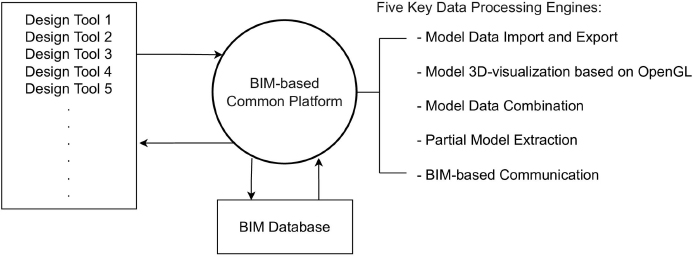 |
Fig. (3). BIM-based common platform of paper (Lai et al., 2019). |
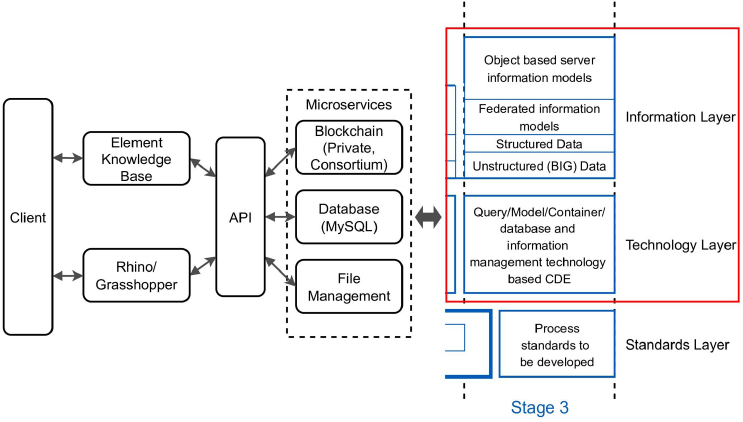 |
Fig. (4). The DISBS system architecture completes the environment of the ISO 19650-1 stage 3 technology layer. |
The record verification process provides the procedures and responsibilities for confirming tampered versions. The proposed DISBS and each main process complete the technology of different levels of ISO 19650-1 stage 3 (Fig. 1), and the following sections explain which level of technology is completed by the proposed approach.
3.1. System Architecture
In this section, we propose DISBS for processing architectural design information. The methods and processes proposed in DISBS not only achieve implementation of the ISO 19650-1 stage 3 technology layer and information layer, but also use a centralised database and decentralised blockchain management mechanism to manage various information from construction projects (Fig. 4). The DISBS primarily provides the usage situation of the architect when designing the project, which is usually not accomplished by one person in terms of completing the entire project.
Architectural work is completed by division of labour and collaboration between the construction teams. Therefore, a mechanism to store architectural information is needed.
Information security and data integrity must be protected to ensure interoperability of information and data integrity. The DISBS system is used to communicate through three microservices: the blockchain, the database, and file management through the API as an intermediary in the element knowledge base and RHINO (Grasshopper).
3.1.1. Element Knowledge Base
The element knowledge base is composed of building knowledge for architects. Designers can upload their elements to the element knowledge base; then, these elements receive safety management and protection. Other designers can download related components from the element knowledge base to save project component design time.
3.1.2. Rhino/Grasshopper
Rhino is a CAD application software implementation for three-dimensional (3D) graphics that is used as a modelling tool by designers. Grasshopper is a visual programming language plugin in Rhino that enables users to write APIs on their own
3.1.3. API
The API is a necessary bridge between front-end software and back-end applications. The function of the API in this system is to communicate the element knowledge base and Rhino drawing software, with microservices acting as the intermediary among the blockchain, the database, and file management.
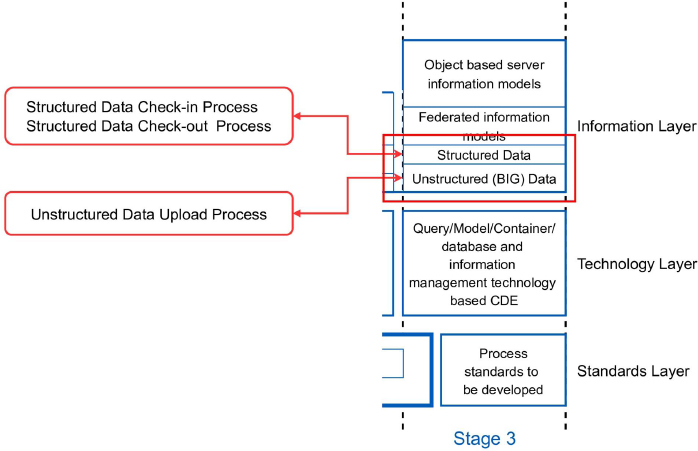 |
Fig. (5). Record generation process corresponding to the 19650-1 stage 3 information layer. |
3.1.4. Blockchain
Blockchain protects the concatenated text content (also called a block) through the concatenation of cryptography. Each block contains the encrypted hash of the previous block, the corresponding timestamp, and transaction data. This design makes it difficult to manipulate the blockchain. The distributed ledger connected by blockchain technology allows both parties to record the transaction effectively and verify the transaction permanently. In our system architecture, we have tested the private blockchain and consortium blockchain. Private blockchain refers to a blockchain where the permission to write is only in the hands of one organisation. However, the transaction speed is fast, privacy is protected, transaction costs are low, and the characteristics of non-tampering are retained. A consortium blockchain is usually more suitable for transactions, settlements, and clearing between institutions. External observers can inquire but cannot conduct transactions. Consortium blockchains are similar to private blockchains, but the degree of openness and decentralisation of the former is limited. The organisation determines the reading, writing, and accounting rights. For example, the consortium blockchain is similar to an industry service, while a private blockchain is identical to an organisation or a company.
The private blockchain is primarily suitable for use by a company or project department. The consortium blockchain is primarily suitable for use by multiple companies or project departments.
3.1.5. Database
With respect to the database, we use the MySQL relational database management system, which distinguishes the storage of the element knowledge base and the project design. The purpose of storage in a database is not only to store the data but also to establish a CDE. The speed of data extraction is faster in the database than in the blockchain. The database facilitates a rapid search of the data, while the blockchain ensures the accuracy and security of the data.
3.1.6. File Management
File management provides a place to store files when the designer finishes the design. The file path in the server is recorded in the database after the designers upload their design files, which can help the designers download the files later when using different computer design software.
Additionally, a collaborative intermediary is applied to protect the original design files.
3.2. Record Generation Process
This section describes the generation process for three records: the structured data check-in process, unstructured data upload process, and structured data check-out process (Figs. 5 and 6), as shown in Fig. (5). The functions of the structured data check-in process and structured data check-out process in the proposed record generation process are the recording processes
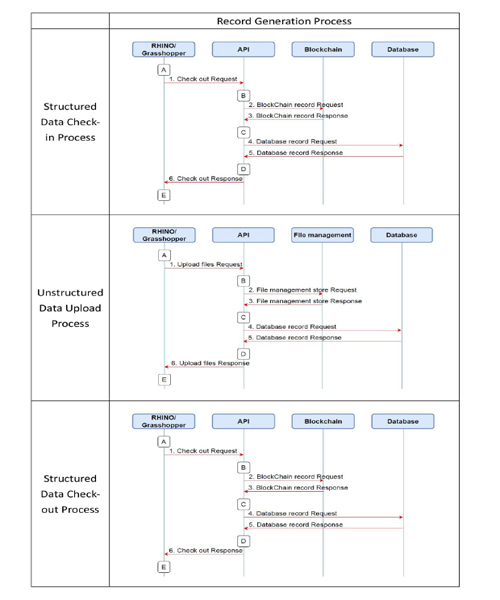 |
Fig. (6). Record generation process. |
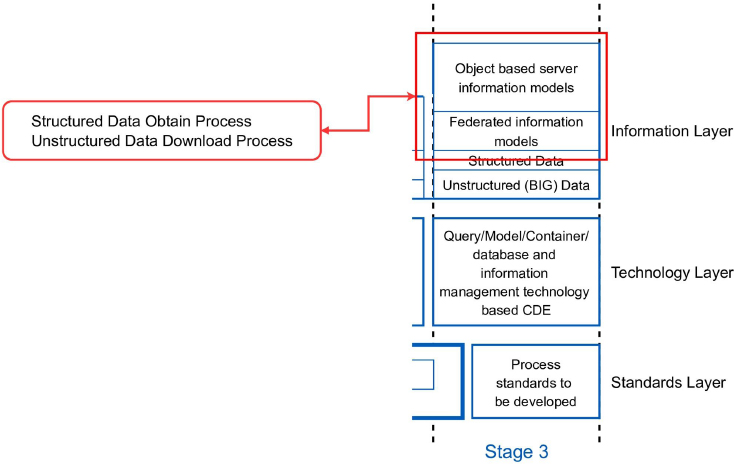 |
Fig. (7). Record search process corresponding to the 19650-1 stage 3 information layer. |
after the project is completed and changed and the structured data part of the ISO 19650-1 stage 3 information layer is completed.
The unstructured data upload process is the process of uploading unstructured data after the project is completed and completing the unstructured data part of the ISO 19650-1 stage 3 information layer. These processes complete the integration of architectural design information records and protect the rights of the original designers.
3.3. Record Search Process
This section describes the search process for two records: the structured data obtaining process and the unstructured data downloading process (Figs. 7 and 8), as shown in Fig. (7). The structured data obtaining process and unstructured data downloading process in the proposed record search process can obtain the structured and unstructured data in the project. The two processes complete the application of a single model using the project design software and complete the ISO 19650-1 federated information and object-based server information models section of the stage 3 information layer. The element knowledge base in the system architecture is the model source of object-based server information models, and the two processes of the record search process use structured data and unstructured data to search for the source of the data model and use it in the design software.
3.4. Record Verification Process
This section describes the verification process for two records: the structured data check-in verification process and the structured data check-out verification process (Figs. 9 and 10). Data security in an ISO 19650-1 stage 3 CDE environment (Fig. 9) can be enhanced through the proposed verification processes. These processes implement procedures and responsibilities to confirm tampered versions.
We have described the proposed system architecture and procedures in this section. The processes of DISBS assist the designer in project collaboration in a centralised and decentralised environment. The DISBS is applied to a curtain wall project and is further analysed.
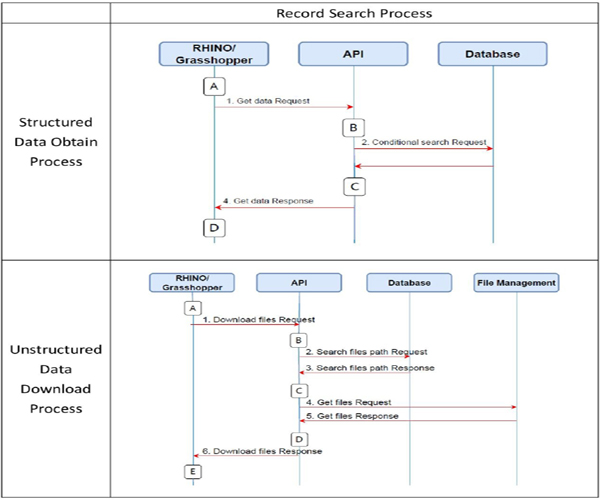 |
Fig. (8). Record search process. |
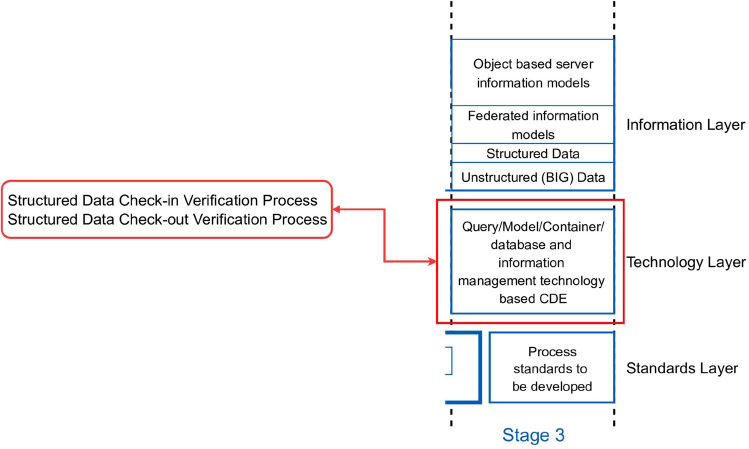 |
Fig. (9). Record verification process corresponding to the 19650-1 stage 3 technology layer. |
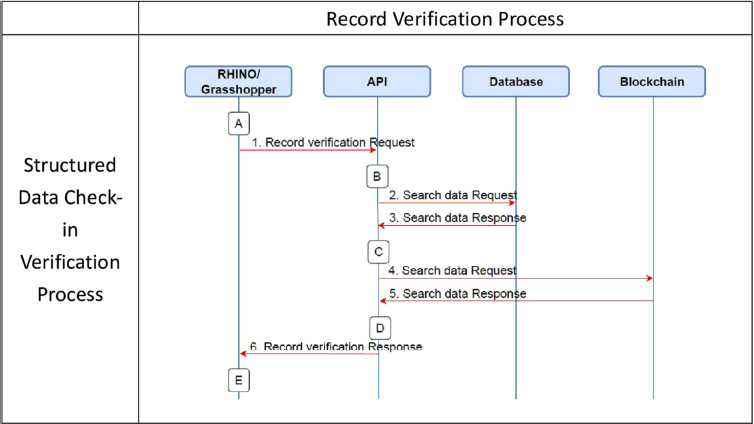 |
Fig. (10). Record verification process. |
4. CASE STUDY: A CURTAIN WALL PROJECT
This section discusses the practical implementation of a curtain wall project in the DISBS system. Project data information can be integrated and protected when the model is in the design stage. Project-relevant data can be searched under design integration. The information related to data changes can be recorded and protected under design changes. Therefore, element location, element parameters, size, material, weight, and the label must be considered. Finally, the accuracy of the information can be verified when design problems and disputes occur. Figs. (11-13) show a curtain wall project in practice, i.e., the Kaohsiung Marriott hotel, where the designer uses RHINO/Grasshopper to design the curtain wall. This section is divided into two scenarios to explain the relative differences under a design change.
In scenario 1 (Fig. 14), the designer builds the design, and a design change occurs using the same computer. In scenario 2 (Fig. 15), the practice engineer completes the project design, and then, a design change follows by using different computers. The recorded video shows scenario 1 [37] and scenario 2 [38]. These two videos simulate the Marriott hotel in different collaborative environments, from the initial project design to the design change that occurs during planning and construction and the final design verification for responsibility attribution. The designer finishes designing the curtain wall panels and exports the 3D model (.3dm, .rvt. . .) formatted files using the structured data check-in process to integrate the project information. The DISBSconfigures the unique element ID to each piece of curtain wall panel information when the designer finishes the structured data check-in process. Each curtain wall panel has a unique element ID, and the designer uses the unstructured data upload process to upload each element file of the curtain wall. When another collaborative engineer needs to utilise the design, they use the structured data obtaining process developed by the system to synchronise and integrate information and the unstructured data downloading process to download element model files. During collaborative design, collaboration members use the Grasshopper plugin to import the element files and display models in Rhino. When there is a design change, the design engineer uses the structured data check-out process to record and protect the information change and to check out the data from the system after the new elements are completed. The structured data check-in process is used to upload the new element information to the server; the server also configures the unique element ID for each piece of element information and uses the unstructured data uploading process to upload new element files. The design engineer can use the structured data obtaining process in the system to search for new design elements. The DISBS records the check-out information of the old elements. Design engineers can use the Grasshopper plugin to import the new design element files and display models in Rhino. The DISBS uses the structured data check-in verification process/the structured data check-out verification process to confirm the security and correctness of the check-in/check-out information when project design problems and disputes occur.
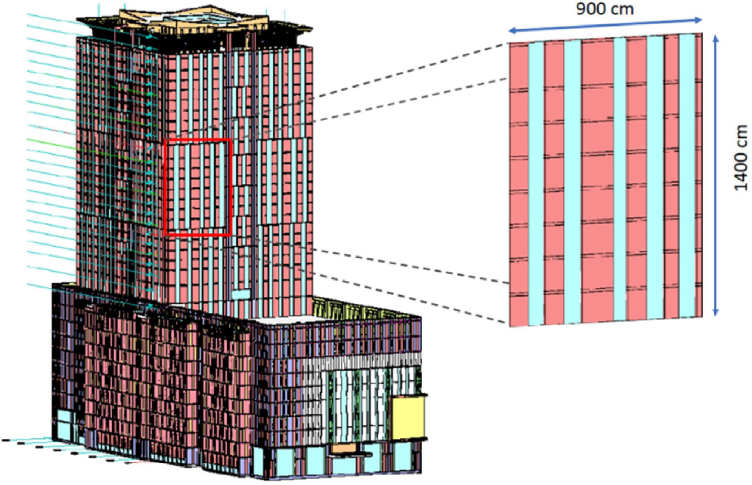 |
Fig. (11). A curtain wall project in practice - Kaohsiung Marriott hotel. |
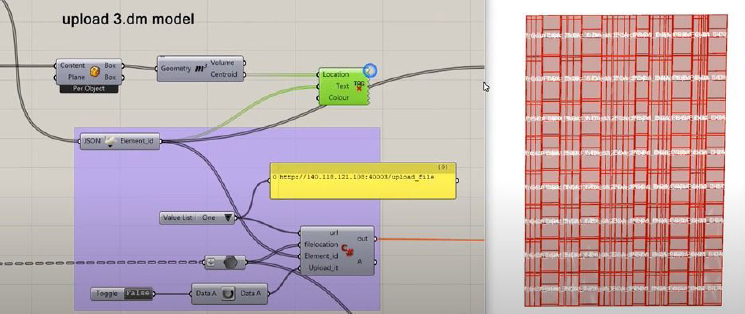 |
Fig. (12). Rhino Grasshopper design process. |
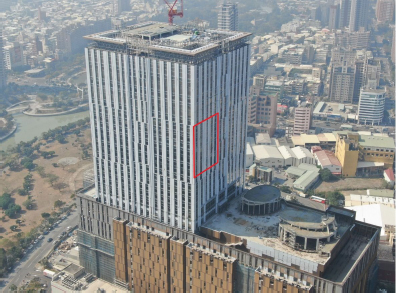 |
Fig. (13). Marriott hotel actual graphics. |
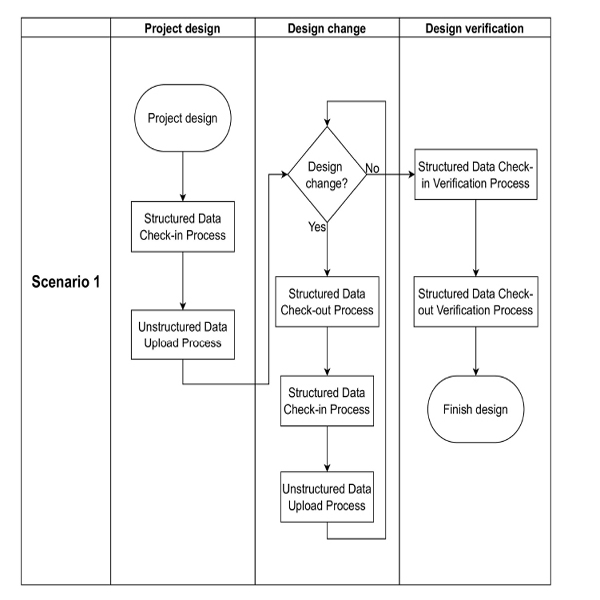 |
Fig. (14). Scenario 1. |
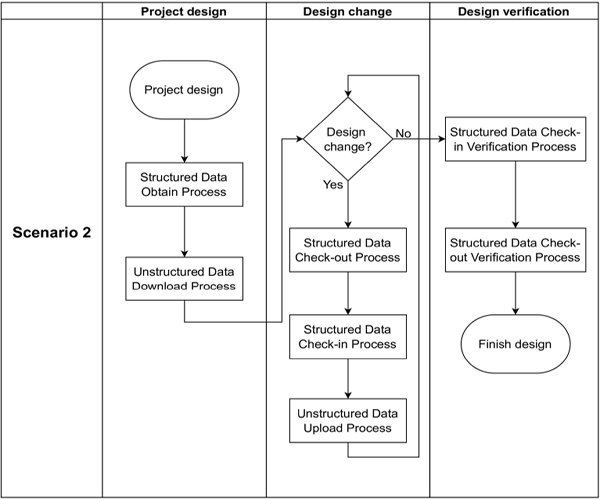 |
Fig. (15). Scenario 2. |
The DISBS system assists a project designer or a collaborative designer in the information security management process, which is described as follows:
• It records the original safety and modification process of the curtain wall project.
• It responsibly ensures the completion of the design when a problem occurs and traces the various time statuses.
• It integrates the existing design and its software for information sharing.
• It provides security to the design and the copyright of the project designer.
5. PRACTICAL IMPLEMENTATION AND ANALYSIS
This section introduces a practical case study of a curtain wall project and its performance analysis. The approach implements the test environment of the private blockchain. Analogously, consortium blockchain two-node and three-node environments are developed (Fig. 16). In addition, the synchronisation environment of the two-node and three-node architectures is shown (Fig. 16).
The implementation divides the two scenarios based on the three blockchain architectures to discuss their performance analysis. The analysis simulates the architect’s project design of 80 curtain wall panels in a physical project. The simulation uses the 6 newly designed curtain wall units to make design project changes. Finally, the analysis performs security verification of the project information records.
5.1. Latency Analysis of the Proposed Methodology
Table 1 shows each process and time consumption of the different structures in scenarios 1 and 2. The table displays the process used in the project design, design changes, and design verification. When designing the project in scenario 1, the structured data check-in process and the unstructured data uploading process are used to record and protect the curtain wall project information.
When designing the project in scenario 2, the structured data downloading process and the structured data obtaining process are used to obtain the curtain wall project information of the design. The designer uses the structured data check-out process, the structured data check-in process, and the unstructured data uploading process to finish the design change in scenario 1 or scenario 2. When verifying the project design, the structured data check-in verification process and the structured data check-out verification process verify the curtain wall project information and the changed records. The table also shows the process and time required to complete the curtain wall project under different architectures.
Table 1 shows the total time required to complete the curtain wall project under different scenarios and architectures, including databases, private blockchain, and consortium blockchain (two-node and three-node configurations). The colours of the squares in the figure represen different system architectural colours. The y-axis represents the time required to complete the curtain project in milliseconds. In scenario 1, the total time required to finish the curtain wall roject using the database structure is 7,913.40 msec. In scenario 2, the total time required tofinish the curtain wall project using the database structure is 3,299.28 msec. In scenario 1, the total time required to finish the curtain wall project using the database and a private blockchain structure is 223,
| Scenario | Status | Process | Database Only(msec) | Database with Private Blockchain(msec) | Database with Consortium Blockchain(two-node) (msec) | Database with Consortium Blockchain(three-node) (msec) |
|---|---|---|---|---|---|---|
| 1 | Projectdesign | Structured data check-in process(80 panels) | 4,822.73 | 107,695.59 | 94,653.36 | 97,694.15 |
| Unstructured data uploading process(80 panels) | 70.75 | 70.75 | 76.15 | 74.75 | ||
| Designchange | Structured data check-out process(6 panels) | 2,769.63 | 10,206.40 | 7,587.58 | 7,666.31 | |
| Structured data check-in process(6 panels) | 245.65 | 7,389.79 | 7,113.61 | 7,302.39 | ||
| Unstructured data uploading process(6 panels) | 4.63 | 4.63 | 3.52 | 3.61 | ||
| Designverification | Structured data check-in verification process(80 panels) | 0 | 91,385.00 | 88,651.15 | 90,471.51 | |
| Structured data check-out verification process(6 panels) | 0 | 6,777.35 | 6,702.38 | 6,797.84 | ||
| Total process time | 7,913.40 | 223,529.52 | 204,787.75 | 210,010.55 | ||
| 2 | Projectdesign | Unstructured data downloading process(80 panels) | 0.12 | 0.12 | 0.13 | 0.14 |
| Structured data obtaining process(80 panels) | 279.24 | 279.24 | 378.89 | 373.47 | ||
| Designchange | Structured data check-out process(6 panels) | 2,769.63 | 10,206.40 | 7,587.58 | 7,666.31 | |
| Structured data check-in process(6 panels) | 245.65 | 7,389.79 | 7,113.61 | 7,302.39 | ||
| Unstructured data uploading process(6 panels) | 4.63 | 4.63 | 3.52 | 3.61 | ||
| Designverification | Structured data check-in verification process(80 panels) | 0 | 91,385.00 | 88,651.15 | 90,471.51 | |
| Structured data check-out verification process(6 panels) | 0 | 6,777.35 | 6,702.38 | 6,797.84 | ||
| Total process time | 3,299.28 | 116,042.54 | 110,437.27 | 112,615.27 | ||
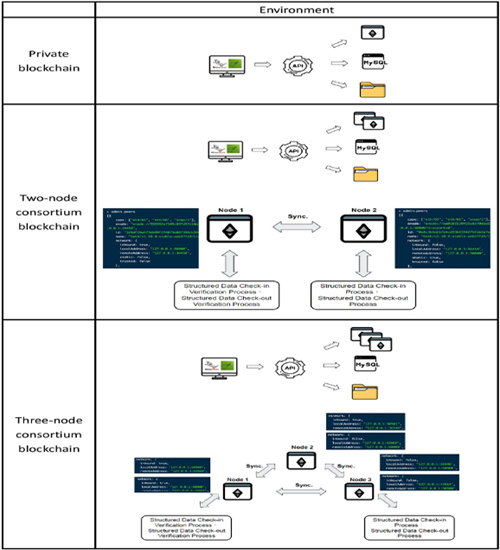 |
Fig. (16). Blockchain environment. |
529.52 msec. In scenario 2, the total time required to finish the curtain wall project using the database and a private blockchain structure is 116,042.54 msec. In scenario 1, the total time required to finish the curtain wall project using the database and the consortium blockchain with the two-node structure is 204,787.75 msec. In scenario 2, the total time required to finish the curtain wall project using the database and the consortium blockchain with the two-node structure is 110,437.27 msec. In scenario 1, the total time required to finish the curtain wall project using the database and the consortium blockchain with the three-node structure is 210,010.55 msec. In scenario 2, the total time required to finish the curtain wall project using the database and the consortium blockchain with the three-node structure is 112,615.27 msec.
Table 1 shows that the fastest speed is achievable by only using the database because it saves the time necessary to upload data on the blockchain. The second fastest speed is of the two-node consortium blockchain. The main reason for this is that since two nodes are used to verify transactions, uploading to the blockchain can be sped up. The third fastest approach is the three-node consortium blockchain. Although the three nodes are synchronised, the three-node consortium blockchain takes more time to synchronise in practice. The slowest approach is the single-node private blockchain. Because there is no other node to help verify transactions, uploading data to the blockchain is relatively slow. However, using more nodes incurs a greater reliance on hardware performance, and thus, different architectures have advantages and disadvantages. In terms of timing, the time consumption without blockchain is shorter. It is negligible compared to triggering the model in design software. To achieve tamper resistance in AECO, the information security mechanism is worthwhile.
6. RESULTS AND DISCUSSION
6.1. Case Analysis
6.1.1. Case Analysis between the Blockchain and RDBMS
When comparing blockchain with RDBMS [39], whether RDBMS is a single or multiple centralised database, the authorised manager is responsible for managing the database. If the security of the authorisation is compromised, the data can be hacked to modify or even delete the data. Blockchain consists of several distributed nodes. Every node participates in verification, all nodes synchronise new information from the blockchain, and then the new data can be updated to the blockchain. For the blockchain, the information in the node must be consistent. The consensus mechanism ensures the security of the network, making it difficult to tamper with. However, blockchain has a safety network mechanism. A traditional RDBMS can perform four functions on data: create, read, update, and delete (collectively known as CRUD commands). Blockchain is designed to only add more data in the form of additional blocks. All previous data and records are permanently stored and cannot be modified. Operations related to the blockchain are read and write operations. This work has used the decentralised blockchain (single-node or multi-node) and centralised database technology separately. The main reason for this is that when the amount of data is larger, it takes longer to query the data on the node. Considering the efficiency of data transmission that may occur during collaboration, information is mainly obtained from the centralised database. When disputes arise, the attribution of responsibility is confirmed from the data stored in the blockchain.
6.1.2. Case Analysis in the Construction Industry
With the current centralised authorisation, we must fully trust the centralised authority for our data or assets. In this case, the central authority must play the role of the system administrator.
The value that blockchain brings to the construction industry can enhance BIM in the areas of security, accountability, transferability, and real-time data collection [40]. Construction companies can record changes in BIM models for their building environments using the blockchain’s immutable record feature. Sharing these changes with external collaborators ensures that these changes are time-stamped and immutable. Blockchain also provides the same information content for subcontractors, contractors, and owners. The value brought by the blockchain is that it allows individuals to have ownership of assets or information and can immediately transfer them to any person, company, or machine without relying on third-party intermediaries. This technology eliminates the need to trust centralised managers and achieves information transparency and higher security. Construction supply chains are often ad hoc and centralised with one-off projects delivery. This leads to instability and information dispersion during design, resulting in information transparency problems. The blockchain-based information exchange for the BIM process increases the level of data sharing transparency and trust among project collaborators, thereby helping to reduce corruption and disputes that lead to inefficiencies.
Blockchain technology has great potential to facilitate commercial activities throughout project lifecycles in the construction industry, such as better communication or understanding and file sharing [41]. However, there are limited studies and applications of blockchain in architectural practice at present. A study described the use of blockchain technology in the architecture, engineering, and construction (AEC) industry [42]. The study (Nawari NO 2019) [42] discusses how to use blockchain technology to enhance network security and leverage BIM workflows to provide more reliable data storage and rights management, ensuring traceability of changes and data ownership. The paper (Nawari NO 2019) [42] also mentions applications in different fields, such as business, finance, insurance, public sectors, academia, and healthcare. Blockchain systems provide a secure way to facilitate data exchange to verify ownership and availability. Essentially, it is an encrypted data record fixed in a decentralised environment, greatly limiting the possibility of extortion. With the above-related analysis, blockchain technology can improve the workflow in the AECO industry and play a vital role.
6.1.3. Case Analysis in Other Domains
The current application fields of blockchain include medical [43], AI [44], IoT [45], Industry 4.0 [46], etc. In the medical field, blockchain is used to provide patients with a comprehensive and immutable log, allowing patients to easily access their own consultation information. In the field of AI, the use of blockchain applications has been proposed to analyse the decentralised data management of artificial intelligence. In the field of IoT, blockchain has been proposed to change the method of sharing information and improve IoT security and data reliability. In Industry 4.0, blockchain is used in various smart applications, such as smart agriculture, smart healthcare, supply chain, and logistics. In the abovementioned applications, security and privacy of data transmission are major concerns. Many security solutions and standards have also been proposed in recent years to enhance the security level of smart applications, but the existing solutions are all based on centralised architectures. The breakthrough is that the application increases the transparency of building information management.
The use of different blockchain structures increases the trust between project collaborators. Further, the use of blockchain technology eliminates the doubts of trust in centralised management.
The experiment in this paper has been based on the button control in Grasshopper, which the designer determines to send the design result after completion. When multiple users submit different or the same data at the same time, the priority order of the data will be recorded through the timestamp on the blockchain. The proposed process records real-time check-in and check-out information in the project. When the query needs to be validated, the data search is performed according to the timestamp. According to the analysis results of the database architecture in this paper, compared to other architectures, the data storing speed of blockchain is faster. Data are stored in a centralised database that can be accessed by users from different sources. It is more convenient for building information collaboration. However, the attribution of responsibility for informationsecurity and changes is the main issue. The construction industry stores information in centralised and blockchain decentralised databases. The mechanism realises the storage of information and improves the security of the construction project data. Because the distributed database information of the blockchain cannot be modified after it is on board, the project coordinators must ensure the correctness of the information when it is being uploaded. In the consortium blockchain architecture, multinode information sharing is suitable for collaboration between different companies in the industry. However, when the agreement between different companies to share information expires, the previously shared information cannot be recovered.
The application of blockchain technology is less familiar to AECO engineers, and a few applications exist. In the current AECO industry, there is a need to adopt blockchain to achieve information transparency, which can enhance mutual trust and lead to better security among collaborators [47-49]. The blockchain collaboration system proposed in this paper protects the copyrights and interests in the reliable system andmanagement of BIM. It ensures responsibility attribution and resolves the bottlenecks in architecturalpractice. This proposed approach cannot only help the AECO industry connect with blockchain, but also progress towards ISO 19650 stage 3.
CONCLUSION
Based on the results of the analysis of a curtain wall project in the construction industry under the structures mentioned above, we prove the feasibility of the method proposed in this paper. Single nodes can be used by a single designer or a single team to complete the collaboration of the curtain wall roject. Two or three nodes can divide multiple collaborations of the whole curtain wall project, and the designers can perform their designs individually. The designers can finish the designs and then use the two- or three-node blockchain to synchronise and combine them into one project. The results of the analysis indicate that an appropriate system can be selected, and the greatest benefit of the different structure usages can be achieved. The purpose of the proposed method is to help the construction industry achieve a connection with blockchain and move towards ISO 19650-1 stage 3.
When collaborating, the security, reliability, and traceability of information exchange are critical. The current collaboration platform is based on the ISO 19650-1 stage 2 specification for collaboration, but a security mechanism for information exchange is not yet provided. This paper helps to achieve several goals, which are listed as follows: (1) The entire construction industry is provided with an understanding of the technical aspects of the ISO 19650-1 analogy and the maturity stage of digital information management (stage 3). (2) The proposed process can be used to manage structured and unstructured data in the information layer (Fig. 5) and complete the object-based server information and the federated information models by applying a single model to the project design software (Fig. 7). (3) The query/model/CDE based on the information container database and information management technology in the technology layer is complete (Fig. 10). (4) IFC files are no longer used for collaborative information exchange. (5) The copyrights of the project designers and building components are protected to ensure that the modification process and the property responsibility are maintained. (6) In addition, transparency and traceability of information are provided. (7) The proposed method can be quickly identified and determined in the event of a dispute without cumbersome verification. This paper also provides information on GitHub [50] with links and instructions on how to use the code. Users can set up the service according to GitHub’s instructions or use the API service provided in this article to directly implement the DISBS process. In this work, blockchain has been used in the case of building envelopes. The case study performed has also confirmed that blockchain technology can improve data transparency and avoid the data being hacked in centralised management. This can lead to increased trust between the collaborators. The limitations of the method used in this paper are as follows: (1) It is necessary o conduct information technology education and training for AECO staff to become familiar with these functions, and encourage users and enterprises to understand the value of blockchain.
(2) Users must understand how to use the environment that simulates blockchain technology. (3) n the field of AECO, users need to be familiar with the tools of the Grasshopper drawing plug-in nd know how to use the API developed in this paper to connect with the Grasshopper software.
(4) It is necessary for the users to understand the methods and processes proposed in this paper and to become familiar with the timing of each process.
At present, the construction industry is faced with many challenges, especially in the planning of complex projects.
Stakeholders are often faced with issues of construction delays and disputes (e.g., bidding activities, contracting project management, smart manufacturing, project supervision, project management). Therefore, it is necessary to improve the workflow and reliability of information as well as the traceability of information production in the AECO industry. The proposed approach applies the characteristics of blockchain to project cooperation. It ensures that all data in a project can be verified and trusted through realization. The main goals of the proposed approach are to break hrough the silo effect and obtain reliable data information, enhancing transparency and mutual trust between collaboration partners. This can reduce duplications or errors and avoid the loss of important information in the AECO industry
The proposed approach is necessary for enhancing trust between the stakeholders. There is a need to reconsider the entire supply chain, including the selection of building materials, procurement, manufacturing, fabrication, and quality assurance. The entire supply chain needs to be added to the blockchain collaboration system to fully manage the lifecycle of buildings.
CONSENT FOR PUBLICATION
Not applicable.
AVAILABILITY OF DATA AND MATERIALS
Some or all data, models, or codes generated or used during the study will be available from the corresponding author upon request. Some or all data, models, or codes used during the study were provided by a third party. Building envelope BIM model details and system detail information were provided by Gomore Building Envelope Technology Company Ltd. Direct requests for these materials may be made to the provider.
FUNDING
None.
CONFLICT OF INTEREST
The authors declare no conflict of interest, financial or otherwise.
ACKNOWLEDGEMENTS
Declared none.
REFERENCES
| [1] | Salman Azhar, Building Information Modeling (BIM): Trends, Benefits, Risks, and Challenges for the AEC Industry., vol. 11, no. 3, 2011. |
| [2] | S. Rokooei, "Building information modeling in project management: Necessities, challenges and outcomes", Procedia Soc. Behav. Sci., vol. 210, pp. 87-95, 2015. |
| [3] | S. Bertelsen, "Construction as a complex system", Proceedings for the 11th annual conference of the International Group for Lean Construction.2003, pp.11-23. |
| [4] | M.T. Shafiq, J. Matthews, and S. Lockley, "A study of BIM collaboration requirements and available features in existing model collaboration systems", J. Info. Techno. in Const., pp. 148-161, 2013. |
| [5] | T. Beach, I. Petri, Y. Rezgui, and O. Rana, "Management of collaborative BIM data by federating distributed BIM models", J. Comput. Civ. Eng., vol. 31, no. 4, p. 04017009, 2017. |
| [6] | "ISO/TC 59/SC 13 - Organization and digitization of information about buildings and civil engineering works, including building information modelling (BIM)", https://www.iso.org/committee/49180.html |
| [7] | J. Radl, and J. Kaiser, "Benefits of implementation of common data environment (CDE) into construction projects", IOP Conf. Series Mater. Sci. Eng., vol. 471, no. 2, p. 022021, 2019. |
| [8] | M. Laakso, and A.O. Kiviniemi, "The IFC standard: A review of history, development, and standardization, information technology", ITcon, vol. 17, no. 9, pp. 134-161, 2012. |
| [9] | Huahui Lai, and Xueyuan Deng, "“BIM-based platform for collaborative building design and project management", J. Compu. Civil Eng., vol. 33, no. 3, 2019. |
| [10] | S. Tang, D.R. Shelden, C.M. Eastman, P. Pishdad-Bozorgi, and X. Gao, "BIM assisted building automation system information exchange using BACnet and IFC", Autom. Construct., vol. 110, p. 103049, 2020. |
| [11] | James Heatona, Ajith Kumar Parlikad, and Jennifer Schooling, "Design and development of BIM models to support operations and maintenance", Computers in Industry,, vol. 111, pp. 172-186, 2019. |
| [12] | J. Liang, M. Zhang, and Y. Yuan, "Construction Project Collaboration Management Based on the BIM", 2011 International Conference on E-Business and E-Government (ICEE). 06-08 May 2011,Shanghai, China, 2011, pp. 1-4, |
| [13] | Pat Keaney, ", Director, AEC Collaboration Products, Autodesk, Inc. BIM 360", Collaboration, Data Management, and BIM, Fri, 2011. |
| [14] | C. Argiolas, N. Dessì, M.G. Fugini, and B. Pes, Enabling secure and collaborative document sharing in BIM processes, Inf. Sci. Syst., Springer, 2016, pp. 393-402. |
| [15] | J. Park, and H. Cai, "WBS-based dynamic multi-dimensional BIM database for total construction as-built documentation", Autom. Construct., vol. 77, pp. 15-23, 2017. |
| [16] | Michael Nofer, Peter Gomber, Oliver Hinz, and Dirk Schiereck, "Blockchain", Business & Information Systems Engineering, pp. 67-75, 2017. |
| [17] | J. Wang, P. Wu, X. Wang, and W. Shou, "The outlook of blockchain technology for construction engineering management", Front. Eng. Manag., pp. 67-75, 2017. |
| [18] | T. Dounas, and D. Lombardi, "A CAD-Blockchain Integration Strategy for Distributed Validated Digital Design", https://papers.cumincad.org/data/works/att/ecaade2018_226.pdf |
| [19] | M.S. Roudsari, "Michelle Pak Adrian Smith + Gordon Gill Architecture, Chicago, U.S.A., “LADYBUG: A PARAMETRIC ENVIRONMENTAL PLUGIN FOR GRASSHOPPER TO HELP DESIGNERS CREATE AN ENVIRONMENTALLY-CONSCIOUS DESIGN", 13th Conference of International Building Performance Simulation Association. Chambéry, France, August 26-28. |
| [20] | Juan Batiz-Benet, "IPFS -Content Addressed, Versioned, P2P File System (DRAFT 3)", Computer Science - Networking and Internet Architecture,, 2014. |
| [21] | X Tao, M Das, and Y Liu, "Distributed common data environment using blockchain and Interplanetary File System for secure BIM-based collaborative design", Automation in Construction, vol. 130, 2021. |
| [22] | E. Curry, J. O’Donnell, E. Corry, S. Hasan, M. Keane, and S. O’Riain, "Linking building data in the cloud: Integrating cross-domain building data using linked data", Adv. Eng. Inform., vol. 27, no. 2, pp. 206-219, 2013. |
| [23] | M. Das, "Social BIMCloud: A distributed cloud-based BIM platform for object-based lifecycle information exchange", In: Visualization in Engineering, 2015, pp. 1-20. |
| [24] | N.O. Nawari, and S. Ravindran, "Blockchain technology and BIM process: Review and potential applications", ITcon, vol. 24, pp. 209-238, 2019. |
| [25] | R. Yang, R. Wakefield, S. Lyu, S. Jayasuriya, F. Han, X. Yi, X. Yang, G. Amarasinghe, and S. Chen, "Public and private blockchain in construction business process and information integration", Autom. Construct., vol. 118, p. 103276, 2020. |
| [26] | Z. Wang, T. Wang, H. Hu, J. Gong, X. Ren, and Q. Xiao, "Blockchain-based framework for improving supply chain traceability and information sharing in precast construction", Autom. Construct., vol. 111, p. 103063, 2020. |
| [27] | P. Mikell, "Jr. “CAD/CAM: Computer-aided design and manufacturing", Department of Industrial Engineering Lehigh University, 1983, p. 99998. |
| [28] | lee. Wei-Meng, "Beginning ethereum smart contracts programming", https://link.springer.com/book/10.1007/978-1-4842-5086-0 |
| [29] | Zibin Zheng, Shaoan Xie, Hong-Ning Dai, Weili Chen, Xiangping Chen, and Jian Weng, "An overview on smart contracts: Challenges, advances and platforms", Future Generation Computer Systems, pp. 475-491, 2020. |
| [30] | Ruhi Ta, "Building a decentralized application on the ethereum blockchain", 2019 3rd International Symposium on Multidisciplinary Studies and Innovative Technologies, 2019. |
| [31] | "buildingSMART, BIM collaboration format (BCF)", Available from: nical.buildingsmart.org/standards/bcf/ (Accessed on 10 Aug 2020). |
| [32] | "(Textuality and Netscape), Jean Paoli (Microsoft), C. M. Sperberg-McQueen (University of Illinois at Chicago), “Extensible Markup Language (XML) 1.0”, Copyright © 1999 W3C (MIT, INRIA, Keio), All Rights Reserved. W3C liability, trademark, document use and software licensing rules apply", https://www.renderx.com/Demos/fo2html/xml.pdf |
| [33] | M. Khaja, J.D. Seo, and J.J. McArthur, "Optimizing BIM metadata manipulation using parametric tools", Procedia Engineering, vol. 145, pp. 259-266, 2016. |
| [34] | J. Ofoeda, "Application programming interface (API) Research: A review of the past to inform the future", International Journal of Enterprise Information Systems (IJEIS),, vol. 15, no. 3, pp. 76-95, 2019. |
| [35] | D. Curtis Jamison, "Structured query language (SQL) Fundamentals", Current protocols in bioinformatics, Wiley Online Library, 2003. |
| [36] | W. Solihin, C. Eastman, Y-C. Lee, and D-H. Yang, "A simplified relational database schema for transformation of BIM data into a query-efficient and spatially enabled database", Autom. Construct., vol. 84, pp. 367-383, 2017. |
| [37] | "Scenario 1 video", Available from: https://www.youtube.com/watch?v=kKqzjEz9NOY |
| [38] | "Scenario 2 video", Available from: https://www.youtube.com/watch?v=rHM0D4mIAd0 |
| [39] | L. Qin, J.X. Yu, and L. Chang, Keyword Search in Databases: The Power of RDBMS, pp. 681-694, 2009.https://dl.acm.org/doi/abs/10.1145/1559845.1559917?casa_token=5G0b33QotrgAAAAA:LgL6Yy_cffNbMvhXw0D91hyevzJyVmgt0XisivBNymbC7RreQoXMNCINSs46pGEBGKrP0Ll-NjtKy6Y |
| [40] | A.R.U.P. Blockchain Technology Report, Available from: https://www.arup.com/perspectives/publications/research/section/blockchain-technology |
| [41] | R. Yang, R. Wakefield, S. Lyu, S. Jayasuriya, F. Han, X. Yi, X. Yang, G. Amarasinghe, and S. Chen, "Public and private blockchain in construction business process and information integration, automation in construction", Automation in Construction, vol. 118, p. 103276, 2020. |
| [42] | N.O. Nawari, and S. Ravindran, "Blockchain technology and BIM process: review and potential applications, ITcon", https://www.itcon.org/2019/12 |
| [43] | A. Azaria, A. Ekblaw, T. Vieira, and A. Lippman, “MedRec: Using Blockchain for Medical Data Access and Permission Management,” 2016 2nd International Conference on Open and Big Data., OBD, 2016, pp. 25-30. |
| [44] | K. Salah, M.H.U. Rehman, N. Nizamuddin, and A. Al-Fuqaha, "Blockchain for AI: Review and open research challenges", IEEE Access, vol. 7, pp. 10127-10149, 2019. |
| [45] | A. Reyna, C. Martín, J. Chen, E. Soler, and M. Díaz, On blockchain and its integration with IoT. Challenges and opportunities., vol. Vol. 88, Future Generation Computer Systems, 2018, pp. 173-190. |
| [46] | U. Bodkhe, S. Tanwar, K. Parekh, P. Khanpara, S. Tyagi, N. Kumar, and M. Alazab, "Blockchain for industry 4.0: A comprehensive review", IEEE Access, vol. 8, pp. 79764-79800, 2020.https://ieeexplore.ieee.org/abstract/document/9069885 |
| [47] | A.S. Erri Pradeep, T.W. Yiu, and R. Amor, "Leveraging blockchain technology in a BIM workflow: A literature review", Available from: https://scholar.google.com.tw/scholar?hl=zh-TW&as_sdt=0%2C5&q=blockchain+bim&btnG=#d=gs_cit&t=1675606591728&u=%2Fscholar%3Fq%3Dinfo%3AeXptLsSV-EAJ%3Ascholar.google.com%2F%26output%3Dcite%26scirp%3D3%26hl%3Dzh-TW |
| [48] | N.O. Nawari, and S. Ravindran, Blockchain technologies in BIM workflow environment.Computing in Civil Engineering 2019: Visualization, Information Modeling, and Simulation., American Society of Civil Engineers: Reston, VA, 2019, pp. 343-352. |
| [49] | T. Dounas, D. Lombardi, and W. Jabi, "Framework for decentralised architectural design BIM and Blockchain integration", Int. J. Archit. Comput., vol. 19, no. 2, pp. 157-173, 2021. |
| [50] | "GitHub", Available from: https://github.com/xiehuangjun |








